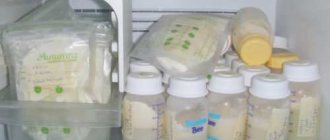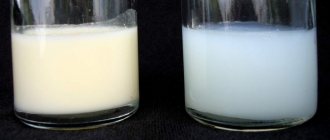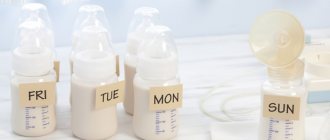All women breastfeeding face the problem of storing milk.
The reasons can be very diverse: the mother’s departure for several days, short-term use of medications and more. In this case, the refrigerator comes to the rescue.
Read the article about how long breast milk can be stored in the freezer and how to store it properly so that it does not spoil.
Is it possible to store the product frozen after pumping?
You can store breast milk in the freezer. This is one of the safest ways to prolong its freshness . Sometimes the bottom compartment of the refrigerator becomes the only way out of the current situation, namely:
- Illness of the mother requiring medication (the main condition is the safety of the milk, the absence of bacteria and viruses in it).
- A child has an illness that requires him to be isolated.
- Baby's refusal to breastfeed.
- Prolonged absence of mother.
Women often express “in reserve”, since at certain periods they have an excess of milk, and sometimes a deficiency. In any of the above cases, food can and should be stored in the freezer.
Does it lose its beneficial properties?
After freezing and first thawing, breast milk does not lose its nutritional value .
Despite the fact that pediatricians agree that it is better to feed a child with fresh food, such food can be offered to an infant.
Of course, after exposure to low temperatures, some antioxidants, fats and vitamins are destroyed. However, these losses are so insignificant that they cannot significantly affect the benefits of the final product. The main thing is to follow the rules for freezing it.
Breast milk, even after freezing, is healthier than the most expensive artificial formula.
Storing breast milk: a few tips
I would also like to give some tips on how to increase the amount of breast milk, which is especially important during the collection period:
- Drink more fluids, especially warm ones;
- Eat well, eat high-calorie foods;
- Get enough sleep;
- Get enough rest:
- Take a multivitamin;
- Drink carrot juice;
- Massage your breasts after feeding;
- Apply your baby more often;
- Drink herbal teas for mothers or special dry protein mixtures (if necessary).
Proper storage of breast milk, personal hygiene and compliance with the rules are the key to your baby’s health, so it is better not to freeze the milk that you plan to give to your child in the next two days in order to preserve the immune factors of the milk. Thawed human breast milk cannot be re-frozen or stored. Before expressing milk, be sure to clean your breast pump and wash your hands with soap and water. Before use, all components of the breast pump, milk collection containers and milk storage containers must be washed and sterilized.
Remember that the breast pump is intended for individual use and should not be loaned to other mothers. Human milk is an ideal food for babies and no artificial formula can replace it. Only it contains all the necessary substances for the maturation of the child’s nervous system and brain, only it helps the formation of all functional systems, protects the baby from diseases and guarantees the formation of strong immunity, therefore it is necessary to make every effort to maintain lactation. **************************************** ************************* Don’t forget to share the information you read on social networks. You can help people who will find this information useful.
Preparation
To prevent the product from deteriorating during storage and losing its nutritional properties, it must be collected and sent to the freezer immediately after expressing .
A prerequisite is compliance with the rules of personal hygiene. Before starting the procedure, you must wash your hands and chest with soap and remove any remaining residue.
If a breast pump is used, it must also be clean. To remove bacteria and contaminants, it is treated with soda slurry, rinsed with water and doused with boiling water. It is not necessary to sterilize disposable containers, as they are sold in individual packaging.
It is better to start pumping after feeding . At this moment, the woman produces oxytocin (a special hormone), which facilitates the process of collecting milk.
How to express breast milk correctly?
In Soviet times, nurses told all new mothers in the maternity hospital in detail and showed them how to properly express breast milk. Formulas were then very expensive, and their availability and quality left much to be desired, so women desperately fought to maintain breastfeeding. Today on store shelves you can find absolutely any formula for any age, but none of them will ever replace a child’s mother’s milk, so pumping remains the main tool in establishing breastfeeding. Pumping helps avoid mastitis when there is too much milk, and stimulates the mammary glands when, on the contrary, there is not enough milk. It also allows you to keep a supply of breast milk at home in case mommy needs to go away. There are 2 main ways of expressing: • manual expression; • expressing using a breast pump (manual or electric). If you don't plan on feeding your baby pumped milk often, collect the milk by hand or using an inexpensive manual breast pump. If you need to be separated from your baby often and for a long time, purchase an electric model.
Manual expression
Many women do not understand how to properly express breast milk by hand. Yes, not everyone succeeds in expressing by hand the first time: it is quite painful and inconvenient. In order for the process to be as efficient and painless as possible, it is important to master a certain technique. Before pumping, it is advisable to thoroughly wash your hands and perform a light massage of the mammary glands. To stimulate milk production, it is also recommended to drink a glass of warm tea. Directly when expressing with your hand, you need to support the breast from below so that your index finger is on the lower edge of the areola. With downward movements of the thumb, the milk is “driven” towards the nipple and, with moderate pressure from the thumb and forefinger, is squeezed out of the breast. If feeding time has not yet come, pumping will proceed very slowly at first: milk will flow out literally drop by drop. After the rush, which you will guess from the familiar signs (heaviness in the chest, tingling, burning), the milk will begin to be expressed in a stream. If, after repeated attempts, you have not been able to figure out how to properly express breast milk by hand, contact a breastfeeding specialist or try using a breast pump: this usually makes the process faster and easier.
Expressing breast milk with a breast pump
A breast pump is a fairly convenient mechanism for expressing breast milk. You simply apply it to your breast so that the nipple is located in the center of a special funnel, and turn on the device (when it comes to an electric model) or rhythmically squeeze the “pear” or lever with your hand (if it is a manual version). How to properly express breast milk with a breast pump is usually written in the instructions for the device. Do not forget to sterilize all elements and containers that will come into contact with breasts and milk.
Shelf life
The shelf life of breast milk in the freezer depends on the temperature, the features of the refrigerator and the location of the container.
According to available data, the product remains usable for the following period of time:
- If the temperature is below -6 degrees: no longer than 3 weeks. We are talking about a freezer with a single door.
- If the temperature is below -15 degrees: no longer than six months. In this case, the freezer should have 2 chambers.
- If the temperature is below -18 degrees: 1 year. Provided there is a separate freezer with its own door.
To keep the product fresh for as long as possible, it should be placed closer to the back wall of the appliance. This will avoid exposure to warm air when opening the chamber.
How long does it last until the next feeding?
You can store milk bottles in several ways. Among them:
- room;
- fridge;
- thermal bag;
- thermos;
- thermal container;
- freezer.
The storage period for expressed milk depends on the ambient temperature. You can focus on the following values:
- +15 C – day;
- +19–22 C — 10 hours;
- +25 C – 4–6 hours;
- above +25 C - no more than 3 hours;
- in the refrigerator from 0 to +4 - up to 8 days.
Frozen milk lasts longer depending on temperature and location:
- Freezer without a separate door - 2 weeks.
- Freezer with a door - 3-4 months.
- Separate freezer with a constant temperature of -19 C - up to 6–12 months.
Pediatricians do not recommend storing expressed frozen milk for more than 6 months, since the product changes its composition as the child grows.
Frozen milk when the baby was 1–2 months old will no longer be suitable for a one-year-old. There is also a risk of losing valuable elements as a result of long-term storage.
Selection of containers
Special bottles for storing expressed breast milk have many advantages. This container closes tightly, has a measuring scale, and is easy to use.
The material safety rating for child health is as follows:
- glass;
- plastic (polycarbonate);
- plastic (polypropylene).
Glass is considered the safest material for a child, but is not entirely suitable for storage at low temperatures: it can easily crack. Plastic and resin are more practical, but you need to carefully study the composition of the manufacturing material.
There is no need to buy bottles that contain bisphenol A. It negatively affects the child’s endocrine system.
If the baby is fed expressed milk only occasionally, the raw materials for making bottles are not particularly important, since they are not capable of causing significant harm to the baby’s health. In this case, they focus on the simplicity and ease of use of a specific brand.
Tara
Finding a container for storing milk is not difficult. For pumping and placing in the freezer you can use:
- glass jars;
- plastic containers;
- ice packs;
- sealed bags.
It is best to opt for the latter option. Packages can be single-use or reusable. They are easy to use, do not leak liquid and do not take up much space. The sealed lock prevents foreign odors from entering.
If a woman cares about environmental friendliness, then glass will be the optimal container . However, such jars are more expensive than plastic products. If accidentally overfilled, they may burst.
When purchasing plastic containers for storing milk, you need to make sure it is safe. The container must be marked that it can be exposed to low temperatures and used for food products. Low-quality plastic is a source of toxins that can poison the product and harm the health of the child. Therefore, the container must be marked BPA free.
To store milk, it is recommended to choose containers from well-known brands that are designed specifically for baby food.
A review of containers for storing breast milk is presented in this article, a review of bags is presented in this article.
How to store
Even expressed milk is much healthier than artificial formula. To prevent such a substance from losing its healing properties, it should be stored correctly.
How to store expressed breast milk? How long should the term last? First you need to determine the storage capacity. Doctors consider glassware to be the best option. You can also use plastic. However, now there are special dishes and bags for storing milk. It is better to use them, since only high-quality materials are used to make such products. Another advantage is that the containers are already sterilized. Pediatricians advise choosing these products.
You can also use containers. They are convenient to store and use in different situations.
Freezing rules
In order for breast milk to remain fresh longer and not spoil during storage, you need to follow the rules for freezing it. Basic recommendations:
- Milk should be expressed only in clean containers. This should be taken care of at the preparation stage.
- The product must be sent for storage as early as possible. If more than a day has passed since pumping, it should not be frozen, even if stored in the top part of the refrigerator. At room temperature, milk should not sit longer than 6-8 hours.
- Before sending for long-term storage, the product must be cooled. For this purpose, place it in the refrigerator, cover the container with a lid and leave for 2 hours.
- The jar, bag or container should not be filled more than 2/3 full, as the liquid expands in size after freezing.
- After cooling, the product is placed in the freezer.
Compliance with these conditions guarantees the freshness of the product throughout the entire shelf life.
In a container
It is convenient to store milk in plastic containers. They do not burst when exposed to cold.
Even if there is too much liquid, plastic particles will not get into the food (unlike glass). After defrosting, the milk fat will not stick to the walls, which is why the nutritional value of the product will not be significantly reduced.
However, plastic is not without its drawbacks. This material is not environmentally friendly, it pollutes the environment. To store baby food, it is better to use special glasses, which are not cheap.
In packages
Airtight bags are a great option for storing breast milk. They have the following advantages:
- the container is initially sterile, individually packaged;
- the bags are durable;
- thanks to the sealed clasp, liquid will not be spilled;
- convenient to remove excess air;
- bags can be attached to a breast pump;
- empty and full bags do not take up much space;
- affordable price.
To accurately track the expiration date of the product, it is recommended to label the packages. To do this, they put a sticker on them with a mark on the date of pumping.
When does it become necessary to feed expressed milk?
Feeding a baby with expressed breast milk is usually necessary in three situations: 1. When there are problems with latching onto the breast. This may be caused by physical weakness of the newborn (in the case of a premature or low birth weight baby, or during a period of severe illness) or an atypical nipple shape (flat or inverted nipple). 2. When the baby does not want to make an effort to get milk. This is often seen in children who have learned what a bottle is. The child very quickly understands that drinking from a pacifier is much easier than from a breast. 3. When the mother cannot be near the child at the time of feeding. This is relevant for women who need to go to work early, continue their studies, or temporarily leave the city. As you can see, if a woman understands how to properly express and store breast milk, she has the opportunity to preserve breastfeeding not only when her child cannot (or does not want) to breastfeed, but also when the mother herself needs to reason to stay away from the baby for some time.
Can it be re-frozen?
The product cannot be re-frozen . If during the initial exposure to low temperatures a small part of the nutrients is lost, then upon re-cooling the milk will lose its original value. It destroys vitamins, proteins, minerals and antibodies.
Repeated freezing is harmful not only by reducing the nutritional value of the product. It always carries the risk of bacterial infection.
When opening the container, microbes may enter and multiply quickly in a liquid environment. Feeding a child such a product is dangerous.
Useful tips
The choice of a specific bottle model will depend on the needs of the family. If you need to store expressed milk for up to one week, then glass containers are quite suitable. If you need longer storage, it is better to choose plastic containers or bags.
You need to warm up the expressed milk if the baby refuses to eat. The recommended temperature is no higher than 37 C. You can check by dropping a drop of milk on your wrist.
It is allowed to warm up:
- in a water bath;
- under running hot water;
- using a special electrical device.
There are conflicting opinions about heating in the microwave. The Russian Union of Pediatricians claims that this is not dangerous, but it is difficult to control the temperature.
Do not heat milk by boiling or in a pan on the stove . If you need to heat up frozen milk, you need to take it out in advance and place it in the refrigerator for 24 hours. Then move it indoors for a while and heat it to the desired temperature using the above methods.
Refrigerated or thawed milk may have a soapy odor. This is considered a variant of the norm and does not indicate its depravity. Cooler bags are ideal for travel and travel.
Helpful information
Tips for storing breast milk:
- You can add a fresh portion to a container with already frozen milk. However, it should be expressed at short intervals. It must first be cooled in the upper part of the refrigerator.
- The 1-year shelf life applies only to the product that was collected and sent for storage in accordance with all the rules.
- The portion that is planned to be sent to the freezer can be assembled up to 12 hours. In this case, the container should be in the refrigerator and tightly closed.
- If the milk has separated into fractions after being removed from the freezer and thawed, this does not indicate spoilage. This consistency is normal. There is fat in the milk that has simply risen to the top. Before offering food to a child, it must be mixed.
Preparing to drink milk after freezing
When the time comes to feed your baby frozen milk, the first question that will arise is how to reheat it properly?
To begin, milk from the freezer needs to be placed in the main chamber of the refrigerator for about 12 hours.
It is very important - after the milk has been completely thawed, it is stored in the refrigerator for no more than 24 hours!
You cannot heat milk in a microwave oven or boiling water - this will negatively affect its properties! It is best to use a bottle warmer or simply place a container of milk in a mug of warm water. The optimal temperature for heated milk is no more than 37 degrees.
Before feeding, shake the container with milk a little, as it separates during storage. But don't shake too hard, otherwise the milk will foam and your baby will swallow air bubbles along with it!
Expressed milk that has been frozen may change color and smell. Mothers often notice that it smells like soap. This is normal. If all collection and storage rules are followed, this milk is absolutely safe for your child!
Attention: used milk, which may have received flora from the child’s mouth, must be used within an hour or thrown away!
Author of the article











